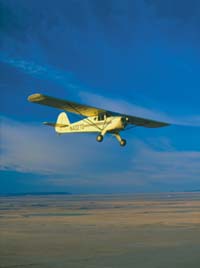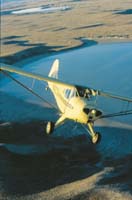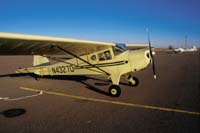
My friend Al had found this specimen derelict on the ramp at the Carrizozo, New Mexico airport back in 1993, and decided to take it on as a restoration project. The Taylorcraft Company turned out hundreds of these efficient, side-by-side, 65-horse power, model BC-12D taildraggers in 1946 and 1947, before the 1948 general-aviation bust. We resolved that this forlorn Taylorcraft would fly again.
After having been assured by demonstration that the engine still ran and developed oil pressure, we removed the wings and loaded the Taylorcraft onto a trailer, facing forward and resting on its mains and tailwheel. Al nearly ran off the road during the drive home when the prop caught enough wind to spin the engine noisily behind him. It was as if the wingless fuselage was trying to make an aircraft-carrier takeoff from the trailer, with a departure straight-out through the cab of the truck. Fortunately, Al has more luck than any 10 pilots I know, so he managed to both stay on the road and to keep the eager Taylorcraft on the trailer.
I dropped by Al’s shop from time to time over the following months to watch enviously as he stripped down and rebuilt the plane. I watched the Taylorcraft take form again, thinking of how a basic “stick-and-rudder” aircraft like this (despite its yokes) would be fun to fly over the open spaces of the rural Southwest. Al had the plane up and flying soon enough, now painted an eye-pleasing pale yellow with brown trim.
Al flew the plane joyfully for a number of months before his ever-present desire for another project took over. When he mentioned that he was selling it, my urge to buy was overpowering. Four like-minded friends and I put together an informal partnership to co-own the plane. The yellow Taylorcraft (also known as the “T-raft,” “T-cart,” or, after a bobbled landing, the “T-bucket”) provided most of our introductions to flying taildraggers, along with some landings noteworthy for their entertainment value.

A five-way partnership isn’t too many for the Taylorcraft. We normally schedule the plane, but, with few exceptions, if the plane isn’t in the hangar when a wild hair strikes someone to go fly, it is usually back within a half-hour or so. One exception was when a partner took the plane to Oshkosh in 1995, putting 30 hrs on the tachometer during the course of the three-week trip. If you look closely, you can see that he’s still vibrating. Another exception was when I took the plane to Centennial, a satellite airport just south of Denver, eking out a groundspeed that, due to the spring Rocky Mountain headwinds, was often significantly and disconcertingly less than that of the speeding traffic on I-25 below.
The cockpit is tight in this aircraft; the pilot and passenger of any size have to take turns breathing. Cross-country trips carrying much more than a toothbrush with a single shot of toothpaste are best done solo. The 50-lb luggage rack doesn’t hold much volume, requiring use of the passenger seat as well as the floor in front of it for storage of luggage and placement of flight materials. Keeping these out of the rudder pedals and control cables, yet available for flight requires careful cockpit management.
Plenty of daylight is another requirement for cross-country flight in the Taylorcraft, since the plane has no electrical system, and thus no navigation lights. This same lack of an electrical system also means starting the engine via the hand-propping method. Propping adds a certain allowable swagger factor when arriving or departing new airports, but is also a significant safety consideration. The engine starts easily every time, and the ease with which it kicks over always gave me pause. I don’t care to think about the number of times I have carelessly turned a prop without checking to see that the mags were off, and without fully appreciating the implied menace each time the magneto clicked. When starting solo, the tail tie-down is left in place, to be untied once the engine starts, the RPM’s are under control, and the pilot is ready to board.

Landing a tailwheel aircraft requires a definitive technique, as well as a certain skill level with that technique. The T-cart is considered to be moderately twitchy, but I decided that something was at fault other than my own technique (or at least in addition to it) about the second time I landed and rolled out into the front yard of one of the houses that fronts the Sandia Airpark runway. Close examination revealed that the tailwheel caster-locking mechanism had become worn. This, in addition to the out-of-adjustment and notoriously weak cable-actuated mechanical brakes, allowed the aircraft to drift serenely but uncontrollably to the left as airspeed bled off to less than that required for rudder effectiveness. Full right rudder and furious stabs at the miniscule right heel brake were futile in controlling the rollout. It was a curiously helpless feeling seeing the scenery of the runway margin roll into view in un-commanded fashion. A new tailwheel assembly fixed the problem, but not before the local prairie dog population had been terrorized.
Although the control surfaces on the Taylorcraft are large, their effectiveness and control authority diminish due to slowing airflow over those control surfaces when airspeed bleeds off in the flare. Compensation for this diminished authority takes the form of even larger and quicker control deflections during deceleration (and conversely, decreasing deflections as airspeed increases in the takeoff roll). Landing in a gusty crosswind takes practice, but the crosswind capability of the aircraft (not listed, but probably about 10 kts) is reasonably good considering its light weight and large wingspan. In fact, it is possible to land the plane in winds that make it near impossible to taxi, especially to turn in a taxi. The large side area of the fuselage and fin, and the high angle of attack in the three-point attitude, make the aircraft want to turn into a strong wind and fly.

Membership in our 5-way Taylorcraft partnership has changed from time to time. In addition to the FAA-mandated tailwheel endorsement for new members, the insurance company usually required 10 to 15 hours of dual in type. Even after 10 hours, the palms of the new taildragger pilot’s hands tended to get sweaty thinking about the tailwheel landing that had to be made at the end of a flight, especially if there had been any of the potentially wilder rollouts during training. Tailwheel training is one of the more demanding types of instruction to give, if only because mistakes are usually made close to expensive and easily damaged objects, including the aircraft itself. One partner and his instructor had the unpleasant experience of catching a gust of wind under the tail on landing. The plane rolled down the runway in a tail-high attitude, leaving a series of shallow slashes in the runway with the tip of the prop, but luckily, it did not go over onto its back.
I nearly put the plane onto its back during a wheel landing one day by thoughtlessly applying brakes in an effort to shorten the rollout to make a turnoff. This was an unfortunate holdover ‘learned’ from similar maneuvers made frequently and successfully with tricycle-gear aircraft. The original Shinn brakes are so weak on the Taylorcraft that it creeps forward during the preflight runup, but they are plenty strong enough in other circumstances. Another taildragger lesson learned - let it roll out.
One partner would take the T-cart out to land on the dry lakebeds near Estancia, NM, practicing his off-field technique. He would drag one wheel gently on the clay surface to make sure it was dry before landing. We could tell if he’d been out to the lakebeds by the presence of mud splatters under the wings from the wheels. If the splatters were under a single wing, he only tested, not landed. A scenario that gave me the willies was the vision of the aircraft breaking through a thin crust of dry mud after landing, and sinking gloriously into a muddy soup below.
The light T-cart has given us a new respect for the New Mexico winds, and it taught us the value of close-in traffic patterns and slips to landing. It’s marginal performance and demanding landings have refined our pilot skills. The beast is still a joy to fly, and teaches me more on every wonderful outing.

